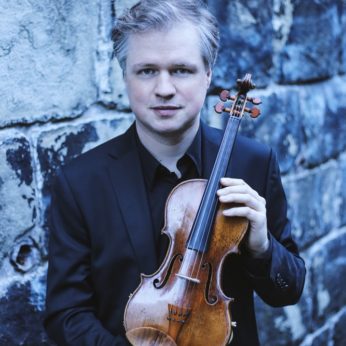Composer: Olivier Messiaen (b. 1908 - d. 1992)
Performance date: 07/07/2019
Venue: Bantry Library
Composition Year: 1941
Duration: 00:55:00
Recording Engineer: Ciaran Cullen, RTÉ
Instrumentation: fl, ob, cl, bn, hn
Instrumentation Category:Small Mixed Ensemble
Instrumentation Other: vn, cl, vc, p
Artists:
Alexei Grynyuk -
[piano]
Henning Kraggerud -
[violin]
Mate Bekavac -
[clarinet]
Laura van der Heijden -
[cello]

Henning Kraggerud [violin], Mate Bekavac [clarinet],
Laura van der Heijden [cello], Alexei Grynyuk [piano]
Olivier Messiaen [1908-1992]
Quatuor pour la fin du Temps [1941]
The apocalyptic imagery and magnificent language of the Book of Revelations has inspired many painters, writers and composers. The announcement of the end of time is a climactic moment that follows the opening of the seven seals and the sounding of the seven trumpets. The seventh trumpet is sounded by a mighty angel, who comes down from heaven clothed with a cloud, with a rainbow upon his head, his face like the sun and his feet like pillars of fire. He bestrides both the land and the sea and his voice unleashes the seven thunders, whose message is too terrifying to be recorded. And this angel then swears that after the end of time the mystery of God shall be revealed. But the other six angels had unleashed a terrifying sequence of horrific disasters upon mankind, including the opening of the bottomless pit and the loosing of the four horsemen of the Apocalypse. To those who had lived through the Nazi conquest of Europe in 1940, it must have seemed that this dreadful era had arrived and that the end of time was imminent.
To stand against this catalogue of horrors Messiaen creates his imagery of the birds. He was at that time imprisoned in Stalag VIII A, a concentration camp at Görlitz in Silesia, after being captured when France was overrun. So the freedom of the birds and the beauty of their song became a potent symbol not just for Messiaen but for all the prisoners.
The first performance on January 15 1941 in front of about 400 frozen prisoners (Messiaen later claimed an audience of 5,000) has taken on a legendary status. Never has my music been listened to with more attention and understanding than on that occasion. The work was written for the instruments and players available, a cello that was reputed to have only three strings (but actually had four) and a piano, whose keys went down but did not come up.
The crystal liturgy takes place from 3-4am as the birds awaken. Messiaen likens the clarinet to the blackbird and the violin to the nightingale, who improvise high in the trees as the darkness lifts. This is also called the harmonious silence of heaven. It is the first time in his work that Messiaen uses birdsong that he was later to explore in such minute detail. The powerful outer sections of the second movement invoke the seventh angel who announces the end of Time. In the middle section the strings float a suspended melody in octaves against a piano carillon that is described as a rainbow of water droplets representing the intangible harmonies of heaven.
The abyss of time, in which we are all trapped, and the freedom of the birds are both represented by the solo clarinet in this extraordinary third movement. It is divided into three sections. The sadness and lassitude of time make up the outer sections. The birds symbolising our yearning for light and stars dominate the central section. The clarinet and its player are taken to their outer limits, the slow tempo putting extreme demands on breath control. The Intermezzo for the clarinet and the strings that follows provides short scherzo-like relief in the midst of the intensity of the rest of the work.
The fifth movement is a duo for cello and piano and the return of the piano is almost shocking after its silence in the two previous movements. The cello is given a long contemplative melody in an almost painfully slow tempo evoking the eternity of Jesus. The piano accompanies with repeated chords. This is the longest movement in the work. It is in the form of an arc with a long slow increase of fervour that then fades back to peacefulness.
Given the apocalyptic disasters that the sounding of the seven trumpets unleashes, this sixth movement seems remarkably restrained. Messiaen describes it as a study in rhythm as the four instruments in unison work on the persistently repetitive melody. But as the movement progresses the dance rhythm gives way to the thunderous announcement of eternity and we get some inkling of the angelic fury of the seven trumpets.
The rainbow, like the birdsong, was an image that Messiaen was to return to many times. He described it as the symbol of peace, wisdom and the vibration of light and sound. In this seventh movement a lyrical and melodic idea is contrasted with the energetic theme from the outer sections of the second movement. The four instruments find their collective voice in dramatic and sonorous fashion in this feverish movement. The final movement is reserved for the violin and piano. It marks a return to the meditative poise of the cello movement. The two instruments move together in a rapt ascension towards the highest register, immobility, fixity, abolition of time.
Francis Humphrys
Copyright © 2024 West Cork Music. All rights reserved.
Designed and developed by Matrix Internet